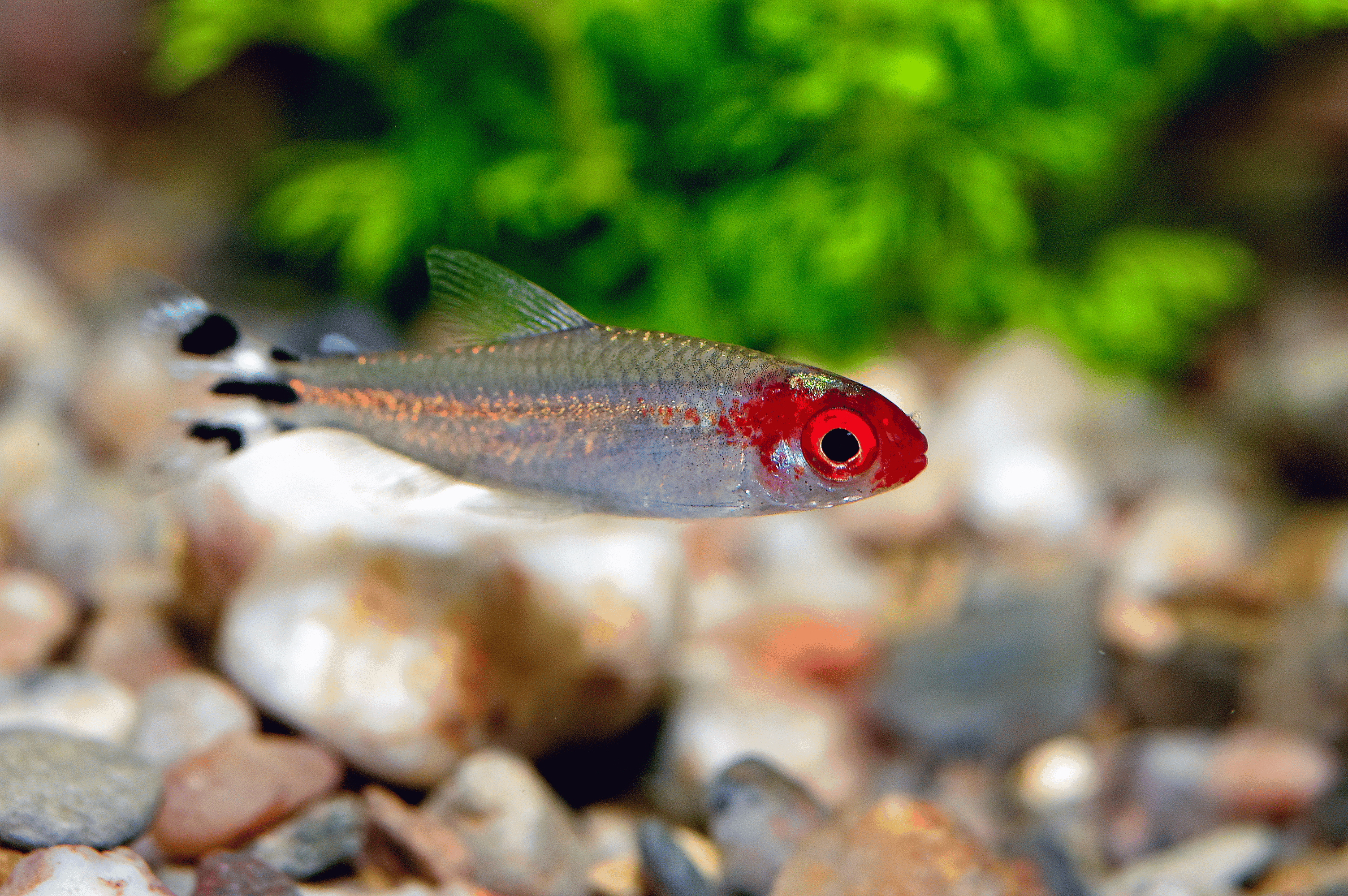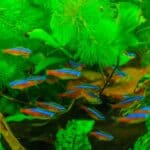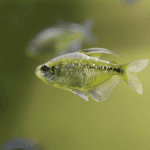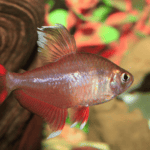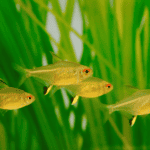Have you ever wondered about adding a dash of vibrant color and unique personality to your aquarium? Rummy Nose Tetra might be the perfect choice! These small, striking fish are not only beautiful to look at, but also offer fascinating behaviors that make them a captivating addition to any aquatic environment. In this comprehensive guide, we will explore everything there is to know about Rummy Nose Tetra, including their care, setup, diet, breeding, and more.
Short Summary
- Rummy Nose Tetras are vibrant and unique fish that require a carefully prepared tank setup, balanced diet, socialization with compatible tank mates and regular maintenance for optimal health.
- Breeding Rummy Nose Tetras requires setting up a suitable 10 gallon tank with appropriate water parameters, filtration system, and vegetation to provide an ideal breeding environment.
- Common signs of stress or illness should be monitored in order to maintain the health of these fish.
Rummy Nose Tetra: A Vibrant and Unique Fish
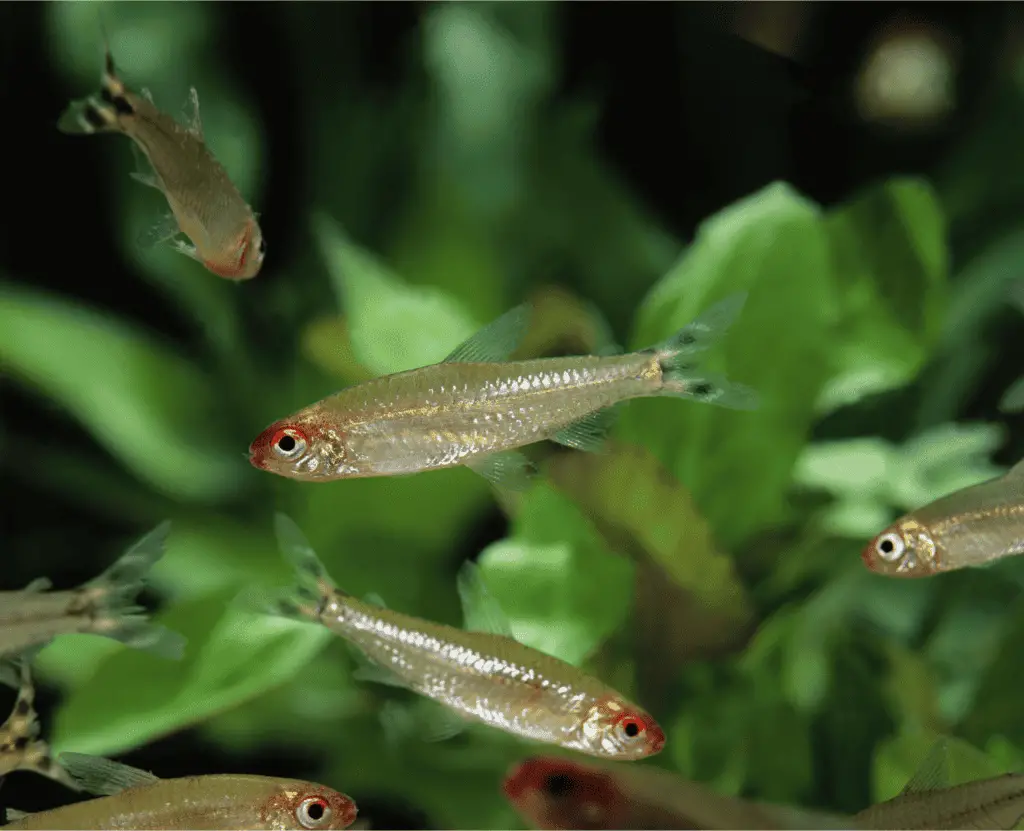
Originating from the Amazon River in South America, Rummy Nose Tetras are small fish with a distinctive appearance that sets them apart from other fish in the aquarium world. Their silver bodies are adorned with deep red heads and zebra-like black and white horizontal stripes on their caudal fins, making them easily recognizable. These peaceful fish are known for their schooling behavior, warmth tolerance, and ability to indicate aquarium health, making them a popular choice among fish enthusiasts.
Rummy Nose Tetras are generally considered hardy fish, as they can accommodate a variety of parameters, making them suitable for novice aquarists. However, it is crucial to obtain healthy specimens and follow proper quarantine protocols to ensure their well-being. Their average size ranges between 1.75 and 2.5 inches, making them an ideal choice for small tanks. In the wild, they are typically found in the middle portion of the water column, and this behavior is also observed in aquariums.
Species Variations
Although Rummy Nose Tetras may appear to be a single species, there are actually three distinct species that share strikingly similar characteristics: True Rummy Nose Tetra (Hemigrammus rhodostomus), Hemigrammus bleheri, and Petitella georgiae. All three species are native to the Amazon River and its tributaries in South America. The most remarkable difference between these species is their size, with the common Rummy Nose Tetra being slightly smaller, at approximately 2 inches. However, other distinctions are minor and extremely difficult to detect, making it challenging to differentiate between the species as well as their genders.
Regardless of the species, all Rummy Nose Tetras share similar behaviors and preferences. They are schooling fish that enjoy swimming together tightly and changing directions in a manner similar to a flock of birds. They thrive in slightly acidic water with temperatures in the range of low to mid 80s°F and are often considered the “canary in the coal mine” of aquariums, as their red noses lose color when they are under stress, signaling potentially hazardous water quality or other issues within the tank.
Caring for Your Rummy Nose Tetra
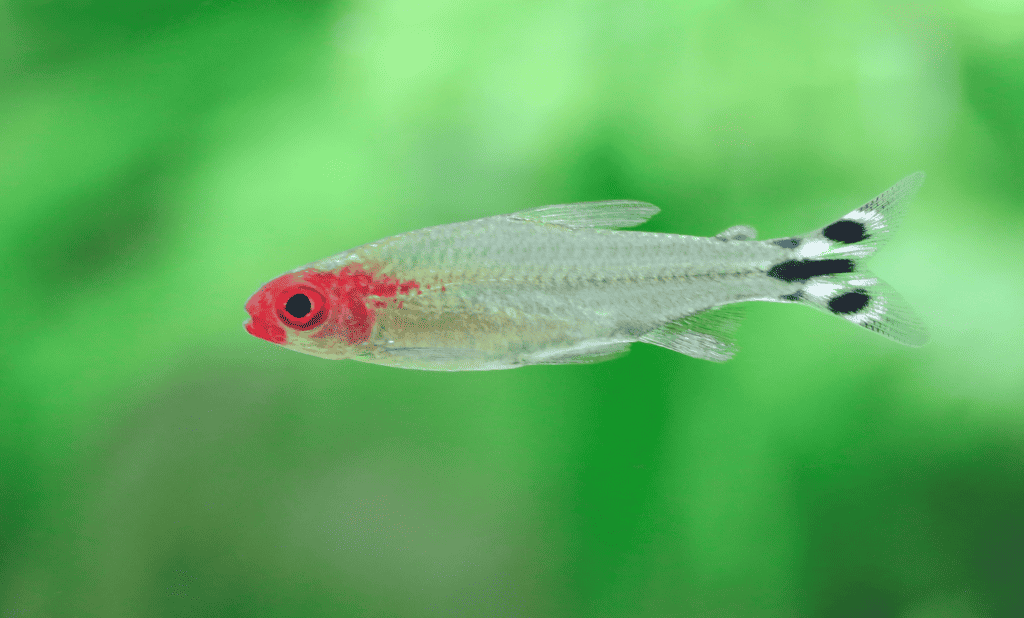
To keep your Rummy Nose Tetras happy and healthy, it is essential to provide them with the proper tank setup and water parameters. They require soft, acidic water and prefer a planted aquarium with a darker background. It is also important to have at least 8-12 tetras in a group, as they are schooling fish and thrive when kept together.
In this section, we will delve deeper into the specific water quality and tank setup essentials for Rummy Nose Tetras.
Water Quality and Parameters
Rummy Nose Tetras necessitate a temperature range of 72-84°F (22-29°C), a pH of 5.5-6.8, and a hardness of 2-8 KH. Maintaining optimal water quality is crucial, as the accumulation of waste and algae can drastically modify the water chemistry, causing stress and illness to the fish. To ensure the best water quality for your Rummy Nose Tetras, it is recommended to change 10% of the water twice weekly and vigilantly monitor conditions. Indian almond leaves or alder cones may be added to the tank to give it a more natural appearance and maintain the water’s softness through peat filtration.
In addition to maintaining proper water parameters, it is essential to provide your Rummy Nose Tetras with the appropriate tank equipment, including a heater, an external filter like the Fluval FX4, and an undergravel filter. These devices will help maintain a stable temperature and clean water, which is vital for the well-being of your Rummy Nose Tetras.
It is also important to remember that loud noises and activity outside the tank can be stressful for these fish and may have adverse effects on their health.
Tank Setup Essentials
Creating the perfect environment for your Rummy Nose Tetras involves more than just water parameters; the tank setup itself plays a significant role in their well-being. A planted aquarium with a darker background is preferred by these fish, as it closely mimics their natural habitat in the Amazon River. They also appreciate a fine, sandy substrate or darker sand, as well as driftwood, rocks, and floating plants to provide some shade. Live plants that extend upward through the water column are also recommended, as they give the tetras a sense of security and a place to hide when they feel threatened.
While an air/water pump is not necessary for Rummy Nose Tetras, as the filter outlet will provide sufficient water movement, it can be added if desired. Overall, the key to a successful tank setup for Rummy Nose Tetras is to replicate their natural environment as closely as possible, providing them with the necessary resources to thrive and exhibit their unique behaviors.
Feeding Your Rummy Nose Tetra
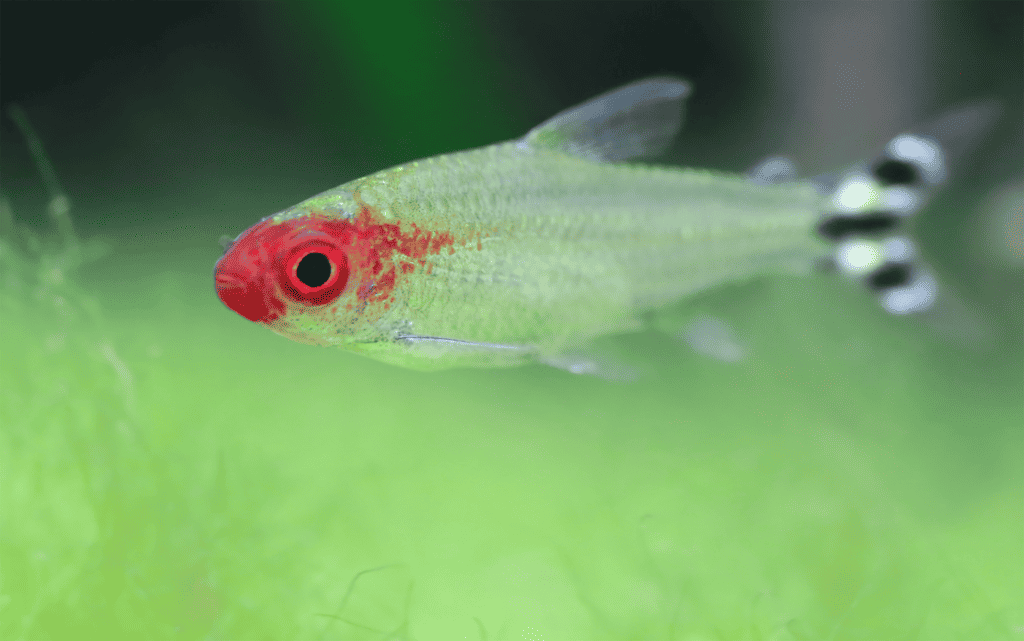
Rummy Nose Tetras are omnivores and enjoy chasing community fish food, making feeding an engaging experience for both the fish and their caretakers. To ensure a balanced diet, it is recommended to feed them twice daily, providing only as much food as they can consume within two minutes. Any uneaten food should be removed promptly, as decaying matter can affect water conditions and contribute to the stress and illness of the fish.
In the following subsection, we will discuss supplemental foods and treats that can be offered to your Rummy Nose Tetras to keep them happy and healthy.
Supplemental Foods
Offering a variety of food sources is essential for the well-being of Rummy Nose Tetras, as it helps prevent potential nutrient deficiencies in their diet. Supplemental foods like blanched vegetables can be easily incorporated into their tank and provide an additional source of nutrients. Occasional treats of frozen or live foods, such as daphnia and bloodworms, can also be beneficial for these fish, providing them with a source of protein and promoting their overall health.
It is important to remember that maintaining a balanced diet is crucial for the long-term health of your Rummy Nose Tetras. High-quality flakes or pellets should form the basis of their diet, with supplemental foods and treats offered occasionally to ensure they receive all the necessary nutrients. By providing a varied diet, you can help your Rummy Nose Tetras thrive and display their vibrant colors and unique behaviors.
Social Behavior and Shoaling
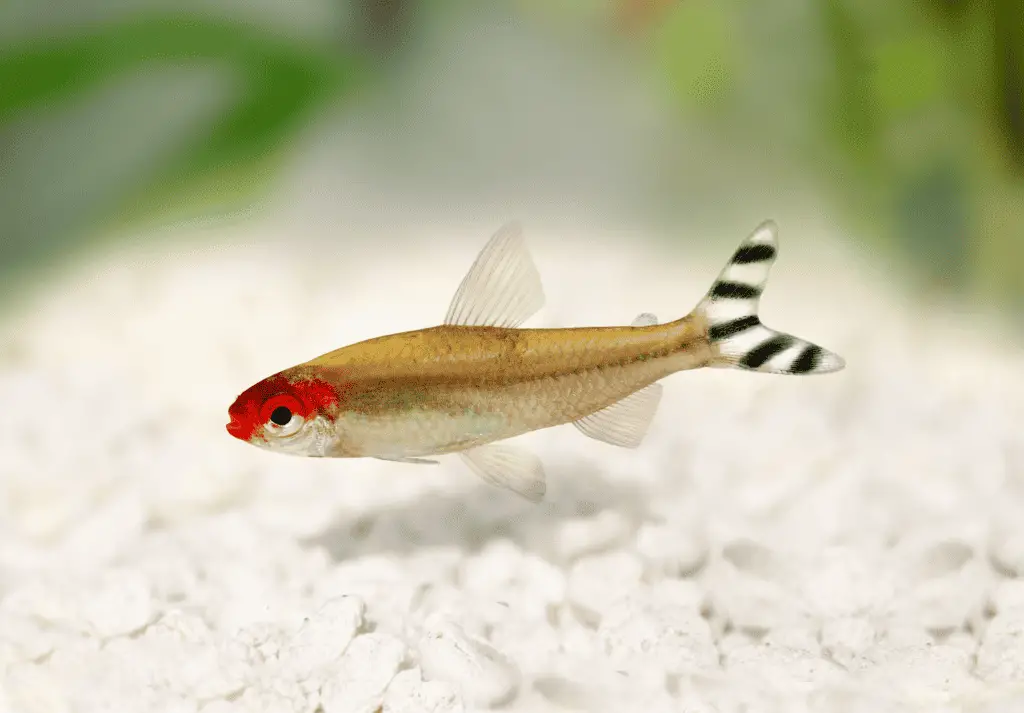
Rummy Nose Tetras are peaceful fish that enjoy swimming together in groups, usually remaining in the middle of the water column. This schooling behavior is not only fascinating to watch, but also essential for their well-being, as they feel more secure when surrounded by their own kind. It is recommended to keep at least 6-8 Rummy Nose Tetras together in a group to observe their distinctive swimming behavior and ensure their happiness.
In the following subsections, we will discuss the ideal group size and number of Rummy Nose Tetras to keep in different tank sizes.
Ideal Group Size
When it comes to determining the ideal group size for Rummy Nose Tetras, the rule of thumb is to have one fish per two gallons of water. A minimum 20-gallon tank can accommodate up to 10 tetras, allowing them to swim together and exhibit their unique schooling behavior. However, it is important to avoid overstocking your tank, as this can lead to increased stress and illness among the fish.
Larger tanks will allow your Rummy Nose Tetras to form larger schools and engage in more complex swimming patterns, enhancing their overall well-being and making your aquarium a truly captivating sight. By providing an adequate group size, you can ensure that your Rummy Nose Tetras thrive and display their beautiful colors and unique behaviors to their fullest potential.
Ideal Number by Tank Size
As mentioned earlier, the general guideline for the recommended number of Rummy Nose Tetras per tank size is one fish per two gallons of water. This means that a 20-gallon tank can accommodate up to 10 Rummy Nose Tetras, allowing them to swim together in a comfortable environment. For smaller tanks, such as a 10-gallon tank, it is recommended to keep a maximum of 5 Rummy Nose Tetras to avoid overcrowding and stress.
When determining the ideal number of Rummy Nose Tetras for your tank, it is essential to consider not only the size of the tank but also the needs of the fish. By providing enough space and an adequate group size, you can ensure that your Rummy Nose Tetras will thrive and exhibit their fascinating schooling behavior and vibrant colors.
Choosing the Right Tank Mates
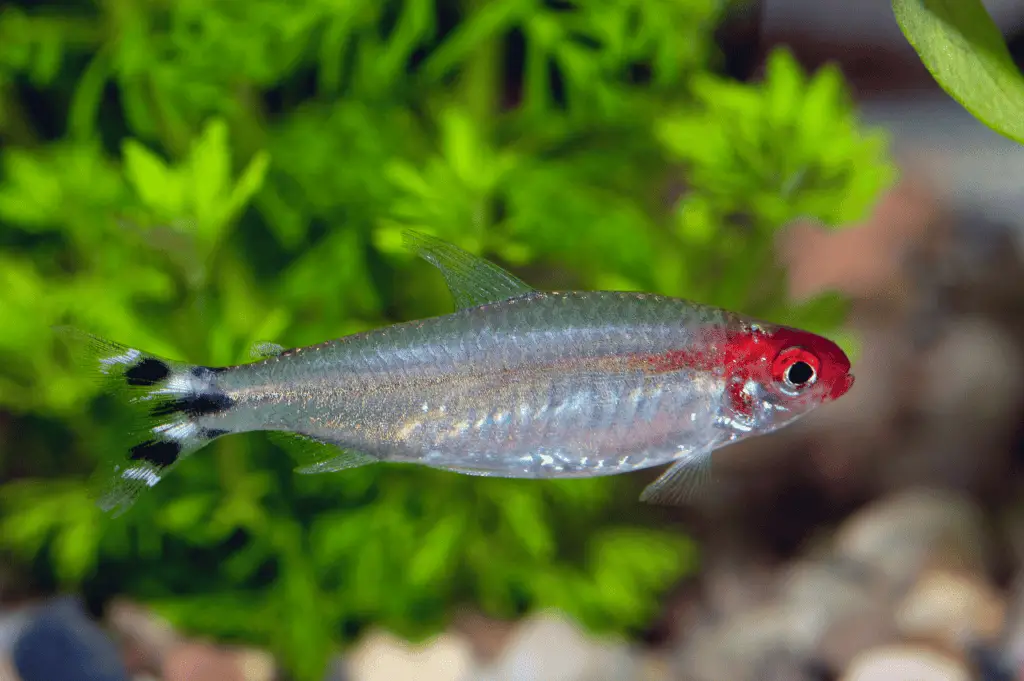
Selecting suitable tank mates for your Rummy Nose Tetras is an important aspect of ensuring their well-being and happiness. Compatible tank mates should be of similar size, temperament, and water conditions, as well as not pose a threat to your Rummy Nose Tetras. Neon tetras, for example, are a suitable choice for tank mates, as they share similar preferences and will not harm your Rummy Nose Tetras.
In the following subsection, we will discuss the types of tank mates to avoid when keeping Rummy Nose Tetras.
Tank Mates to Avoid
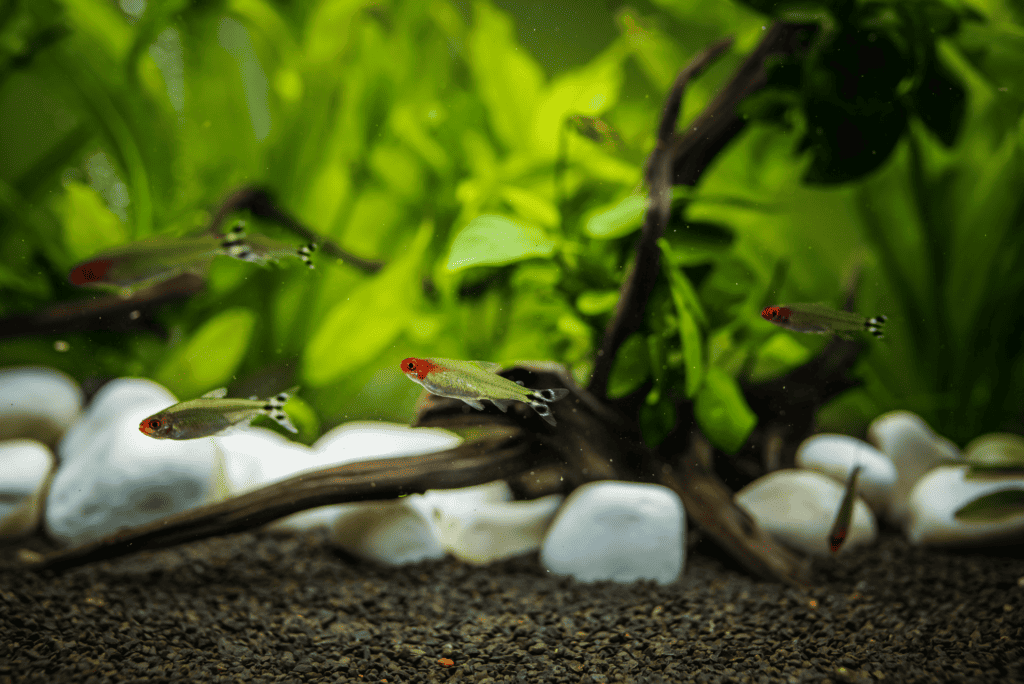
When choosing tank mates for your Rummy Nose Tetras, it is crucial to avoid large and aggressive fish that may consider your Rummy Nose Tetras as food. Examples of tank mates that should be avoided include larger fish such as cichlids, barbs, and other aggressive species. These types of fish can cause stress and harm to your Rummy Nose Tetras, ultimately affecting their health and well-being.
Instead, opt for tank mates that are peaceful and compatible with the needs of your Rummy Nose Tetras. Some suitable examples include small fish like danios, mollies, Corydoras catfish, yo-yo loaches, hatchetfish, harlequin rasbora, and cherry barbs. By carefully selecting appropriate tank mates, you can create a harmonious and visually stunning aquarium environment for your Rummy Nose Tetras and their companions.
Breeding Rummy Nose Tetras
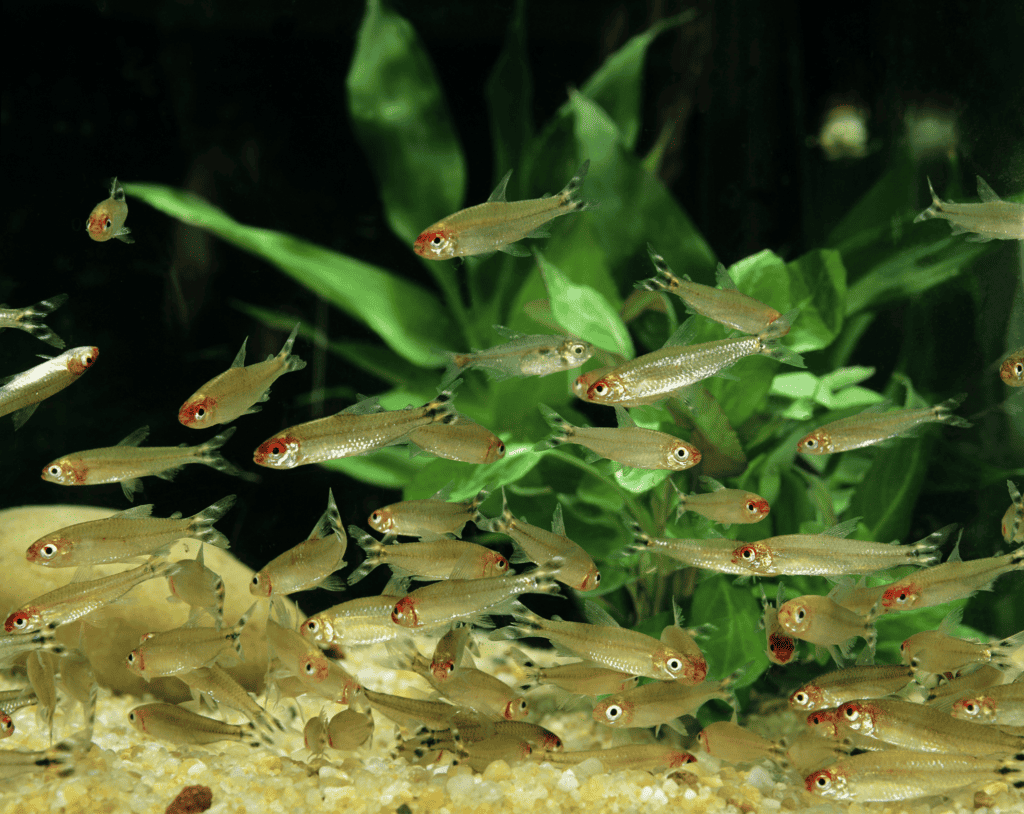
Breeding Rummy Nose Tetras can be a rewarding experience for both novice and experienced aquarists. To successfully breed these fish, it is essential to provide them with a good mix of males and females, warm temperatures, clean water, plants, and specialized fry food.
In the following subsections, we will discuss the necessary steps to prepare for spawning and raising the fry of Rummy Nose Tetras.
Preparing for Spawning
Setting up a suitable breeding tank for Rummy Nose Tetras requires careful attention to water parameters and tank setup. The tank should be approximately 10 gallons in size and include a reliable external filtration system, such as the Fluval FX4. Water hardness should range from 4 to 6 KH, and the pH should be between 6 to 6.2. Additionally, leafy plants, java moss, or a spawning mop should be incorporated into the tank to provide suitable spawning sites for the fish.
It is important to maintain a stable water temperature of around 84°F (29°C) during the breeding process, as this warmth will help trigger spawning in Rummy Nose Tetras. It is also essential to ensure that the breeding tank is populated with a healthy mix of male and female fish, which can be challenging due to the difficulty in distinguishing between the genders.
Raising the Fry
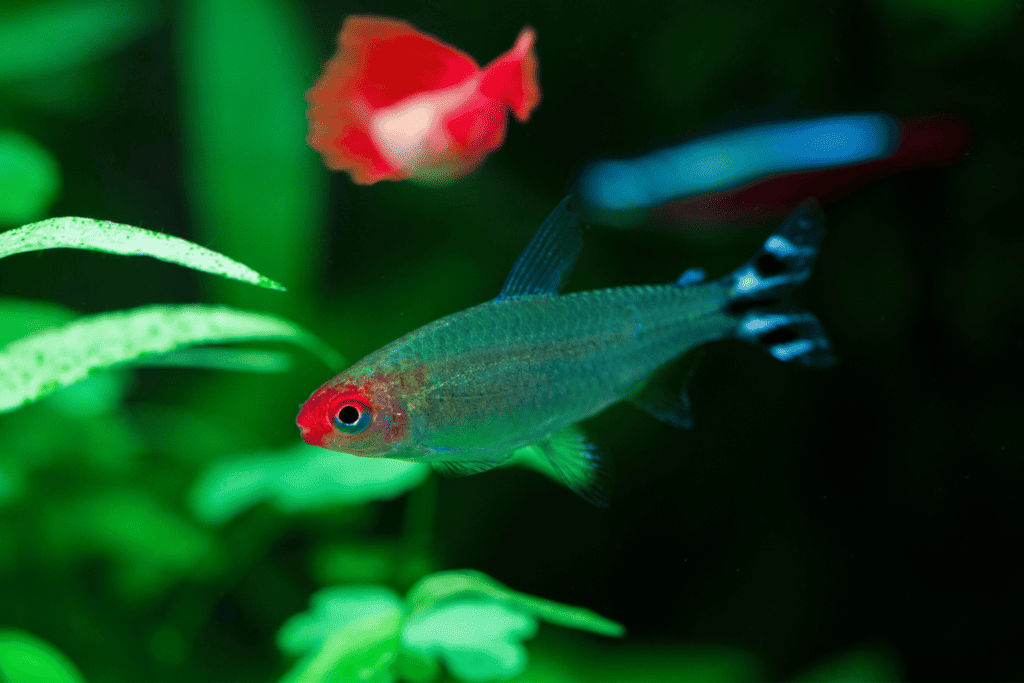
After the female Rummy Nose Tetra lays her eggs on plant leaves or a spawning mop, the male will fertilize them, and the parents should then be removed from the breeding tank. The fry will take 24 hours to hatch, but they won’t be able to swim for another 6 days. After hatching, it takes an additional 6 days for them to develop the muscles and respiration required to move. During this time, they can survive off the egg sacs, which provide them with the necessary nutrients for their initial growth.
Once the Rummy Nose Tetra fry start swimming, it is important to provide them with specialized fry food, as they require small sustenance for the first one to three months of their lives. Rummy Nose Tetra fry are slow-growing, so patience and dedication are required when raising these delicate creatures.
By properly caring for the fry and providing them with the appropriate diet, you can successfully raise a new generation of Rummy Nose Tetras to add to your aquarium.
Common Health Issues and Prevention
Rummy Nose Tetras, like all fish, are vulnerable to illnesses such as Ich and Dropsy. Taking care of these animals requires extra attention in the prevention and treatment of disease. These health issues can often be prevented by maintaining good water quality and promptly quarantining infected fish to prevent the spread of disease.
In the next subsection, we will discuss the signs of stress and illness in Rummy Nose Tetras, which can help you identify potential problems early and take the necessary steps to ensure the health and well-being of your fish.
Signs of Stress and Illness
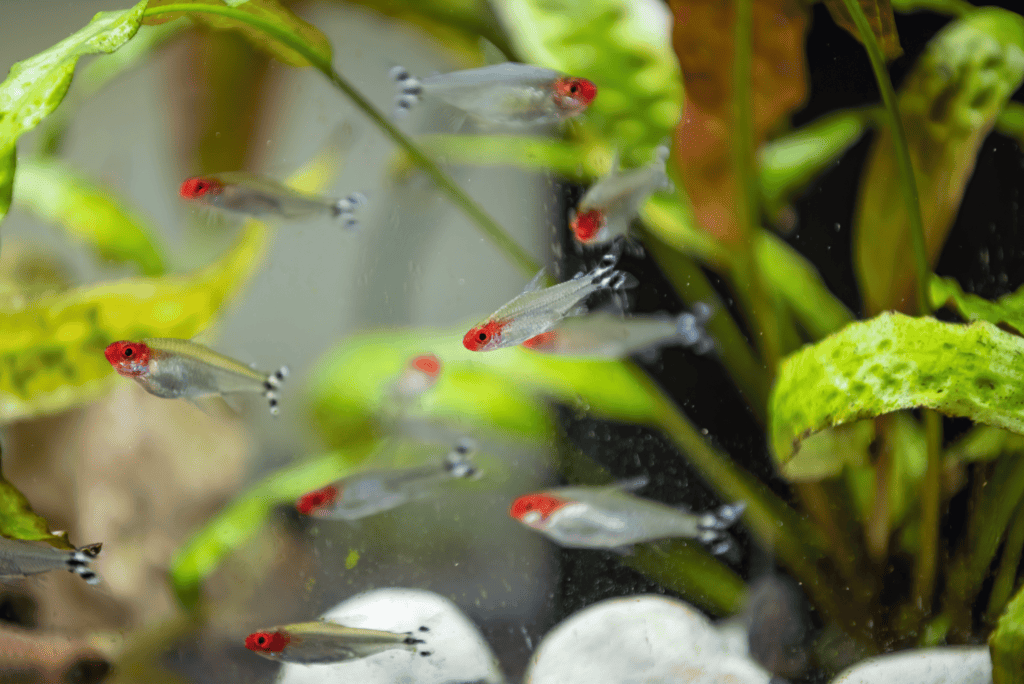
One of the most prominent signs of stress and illness in Rummy Nose Tetras is a change in their red nose coloration, which can become much paler under unfavorable water conditions. Other indications of stress and illness in these fish may include peculiar swimming patterns, accelerated respiration, white spots on their bodies, and a lack of schooling behavior. By closely observing your Rummy Nose Tetras and being aware of these signs, you can take prompt action to address any issues and maintain the health of your fish.
Preventing common diseases like Ich and Dropsy in Rummy Nose Tetras involves maintaining optimal water quality and ensuring that any new fish added to the tank are healthy. In the case of Ich, it is recommended to isolate the infected fish and administer in-water medication to treat the disease. By being proactive in monitoring and maintaining the health of your Rummy Nose Tetras, you can enjoy their vibrant colors and unique behaviors for many years to come.
Frequently Asked Questions
To wrap up our comprehensive guide on Rummy Nose Tetras, let’s address some frequently asked questions about these fascinating fish. The recommended tank size for Rummy Nose Tetras is at least 20 gallons, although larger environments are always preferable. Their average lifespan is 5 to 6 years, which can be impacted by factors such as water conditions and diet.
When it comes to tank mates, it is important to choose fish of similar size, temperament, and water conditions to ensure a harmonious and visually stunning aquarium environment.
Summary
In conclusion, Rummy Nose Tetras are a captivating addition to any aquarium, with their vibrant colors, unique appearance, and fascinating schooling behavior. By providing them with the proper care, setup, diet, and compatible tank mates, you can ensure their well-being and enjoy their captivating presence for many years to come. Whether you are a novice aquarist or an experienced fish keeper, Rummy Nose Tetras are sure to delight and inspire, making them a perfect choice for anyone looking to add a touch of beauty and intrigue to their aquatic environment.
Frequently Asked Questions
Are Rummy Nose Tetras hard to keep?
Rummy nose tetras are easy to keep and maintain, making them an ideal choice for both beginners and experienced aquarists. These fish are hardy and thrive in the right conditions, meaning they require little in terms of care and maintenance.
Therefore, overall, Rummy nose tetras are not difficult to keep.
Are Rummy Nose Tetras peaceful?
Rummy nose tetras are known for their peaceful, gentle behavior, making them an ideal choice for community aquariums. On the whole, these fish are considered to be quite peaceful and docile, so they can make a wonderful addition to any freshwater tank.
Are rummy nose tetras hardy?
Rummy nose tetras are fairly hardy when given the right conditions. However, they can be sensitive to water changes and fluctuations, so it is important to monitor and maintain the tank’s environment. Overall, they are a good choice for aquarists of any level.
